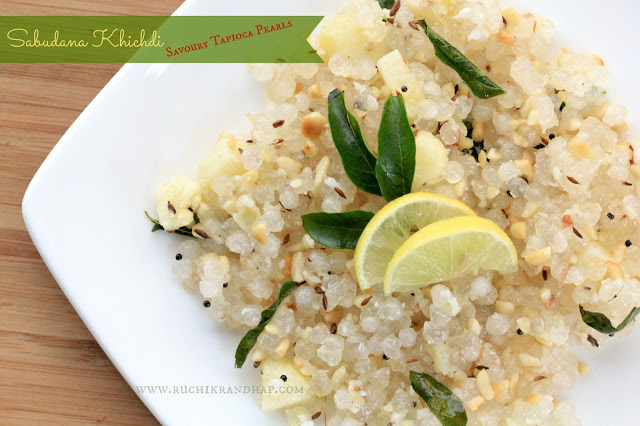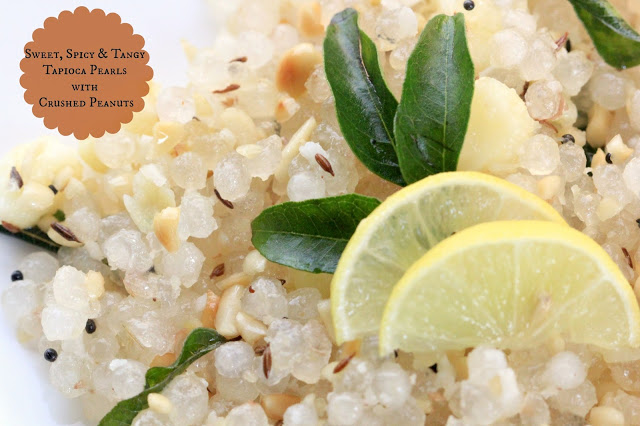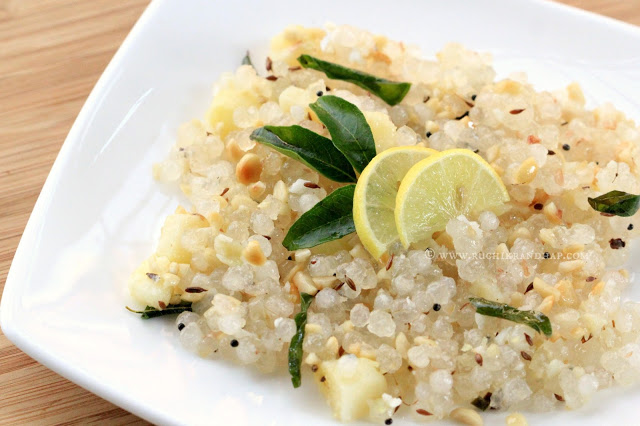The best breakfasts in my opinion are those that are hearty, spicy and complete (read BIG). I am a complete breakfast person and knowing that it is one thing that greatly determines my mood for the rest of the day, I make every effort to ensure that my family & I enjoy a good breakfast.
While I stick to Indian breakfasts, I do enjoy continental spreads and try to replicate them partially at home whenever time permits. Breakfasts don’t need to be complex for me in terms of the process – they just need to be hearty and delicious.
Today’s recipe is a very popular Maharashtrian breakfast recipe that doubles up as a recipe for fasting (vrat). Hindus who maintain religious fasts especially once a week or during special festive seasons tend to prepare Sabudana/Sago/Tapioca pearls in this form. Not only is it devoid of grains which is avoided during fasts, it is a great source of carbohydrates to keep the body functional even when the main grain sources of carb (rice & wheat) is missing. Sago is essentially the pith of the Sago palm, a powdery starch that is processed into globules or pearls. In India Sago is used in the preparation of sweet & savoury dishes, the most famous being the Sago kheer (thin pudding), Sabudana vada (fritters) and Sabudana Khichdi (savoury upma)
I prepared this dish for breakfast when my mum was with me and she thoroughly enjoyed it. She had never tasted it before and really liked the blend of flavours.
About the dish
A classic balance of salty-spicy-sweet & tangy made interesting with a bit of crunch brought in by roasted peanuts (optional) and yummy potatoes. Some recipes use turmeric that gives this dish a beautiful yellow hue, but I skipped it. You may add finely chopped coriander if you wish (which I ran out of when I prepared this). I hope you enjoy this as much as I did!
Sabudana Khichdi
A classic breakfast dish made of tapioca pearls, roasted peanuts & potatoes. A delicious way to start your morning
Print
Rate
Ingredients
- cup sabudana / sago / tapioca pearls
- 1/2 cup unsalted raw peanuts
- 1 medium sized potato boiled (skinned & cubed ,approx 3/4th cup)
- 1/2 teaspoon mustard
- 1/2 teaspoon cumin
- 1 sprig (7-8 curry leaves / kadipatta)
- 1 small green chilly sliced
- 2 teaspoons sugar
- 1 tablespoon oil
- juice of 1/2 a small lime (adjust to taste)
- salt to taste
Instructions
- Wash the sago in 2-3 changes of water and soak it overnight. Next morning, discard the water and place the sago on a sieve or fine slotted colander so that the excess water drains away. Keep aside till required.
- Roast the peanuts on a non stick tawa/pan for a minute or two until the skins have slightly browned - do not burn it. Remove onto a plate and once cooled, rub them between the palm of your hands to remove the skin. (You may keep the skin on if you like). Lightly crush the peanuts using a mortar or pestle or if you desire pulse them 2-3 times in a dry grinding jar of a mixer so you get the texture of broken rice. Do not over blend as they will turn into a sticky paste.
- Heat the oil in a wide based non stick pan/kadhai and add the mustard and cumin seeds. When they stop spluttering, reduce the flame add the curry leaves, green chilly and fry lightly for a few seconds. Add the sugar, salt and stir until the sugar granules have dissolved.
- Add the boiled and cubed potato and mix well, add in the sago and cook on a low flame for 4-5 minutes stirring every now & then. The colour of the sago will change from white to translucent. Do a quick taste check and extra add salt or sugar if required.
- Add the roasted peanuts (if using), sprinkle the lime juice and mix once. Turn off the flame and serve hot garnished with lime wedges.
Notes
Always use freshly packaged sago. Usually two varieties of sago are available, you may use either of them although the smaller variety requires lesser amount of soaking time.
There needs to be a fine balance between the salt & sugar so please adjust both according to your taste.
There needs to be a fine balance between the salt & sugar so please adjust both according to your taste.
Disclaimer
The nutritional values are only indicative.
Tried this recipe?Please leave a comment & rate the recipe below or share a photo on Instagram and tag me @ruchikrandhap



Khichdi looks delicious and healthy.
Hi Shireen,
I can't believe you just posted this! I was looking around for sabudana recipes just about half an hour back! Am definitely going to try this… it's a sign ;).
Cheers,
Laura
Such a healthy and filling khichidi
Omg, khichdi looks wonderful and inviting.
Tried the recipe out. Turned out to be very delicious.